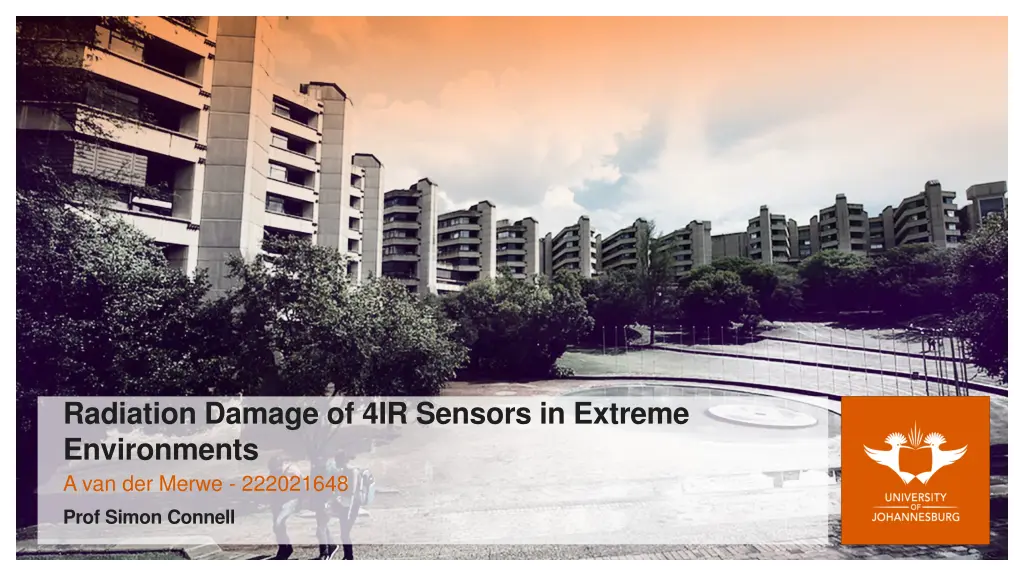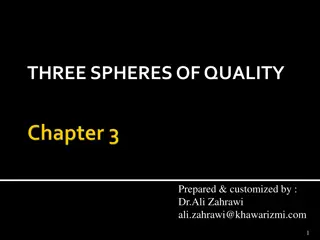
Understanding Radiation Damage in 4IR Sensors
Explore the impact of radiation on 4IR sensors in extreme environments, focusing on the development of radiation-hard fiber optic sensors using silica glass for nuclear reactor applications. The project addresses the need for reliable sensors in high-radiation environments, aiming to enhance sensor durability and performance through innovative design and material compositions.
Download Presentation

Please find below an Image/Link to download the presentation.
The content on the website is provided AS IS for your information and personal use only. It may not be sold, licensed, or shared on other websites without obtaining consent from the author. If you encounter any issues during the download, it is possible that the publisher has removed the file from their server.
You are allowed to download the files provided on this website for personal or commercial use, subject to the condition that they are used lawfully. All files are the property of their respective owners.
The content on the website is provided AS IS for your information and personal use only. It may not be sold, licensed, or shared on other websites without obtaining consent from the author.
E N D
Presentation Transcript
Radiation Damage of 4IR Sensors in Extreme Environments A van der Merwe - 222021648 Prof Simon Connell
Contents Introduction Background Theory Problem Aim Objectives Experimentation Project significance Conclusion References Questions 2
Introduction: Project Context: Addressing the need for reliable sensors in nuclear reactors. Relevance: Current sensors lack full radiation hardness, impacting performance. Scope: Focus on developing radiation-hard fiber optic sensors using silica glass. 3
Background: Global Context: Over 100 countries shifting to green energy and carbon neutrality. Nuclear Energy: Sustainable, efficient, economically viable, but safety concerns persist. Fiber Optic Sensors: Enhance safety via in-core monitoring of water level, humidity, temperature, and neutron flux. Benefits: Small, lightweight, unintrusive, intrinsically powered, high bandwidth, immune to EM. Applications: Used in CERNs Large Hadron Collider and space instrumentation. 4
Theory: Concepts: Utilizes fiber Bragg gratings and distributed sensing for fiber optic sensors. Radiation Effects: Point defects in silica sensors under radiation cause issues like radiation- induced attenuation, emissions, and refractive index changes [1][2]. Mechanisms: These defects manifest as optical absorption and optical luminescence bands, impacting sensor performance [1]. Implication: Understanding these effects is crucial for developing radiation-hard sensors. 5
Problem: Issue: No fully radiation-hard sensors exist; accuracy suffers, requiring replacements every few months. Cause: Point defects from irradiation cause radiation-induced attenuation, emission, and refractive index changes. Solution Approach: Shift to fiber optic sensors with fiber Bragg gratings for light reflection and distributed sensing with multiple gratings. Potential: Silica glass shows promising radiation hardness for in-core measurements; dopants alter properties, necessitating new designs. 6
Aim: Goal: Determine optimal composition and dopants for desired radiation hardness in fiber optic sensors for nuclear reactors. Approach: Understand damage mechanisms including radiation-induced attenuation, emission, refractive index change, lattice dilation, densification, and darkening. Factors: Analyze effects of point defects and dopants like non-bridging oxygen hole centers, dangling silica bonds, peroxy radicals, self-trapped holes, and self-trapped excitons. Outcome: Develop sensors with enhanced durability for reactor core applications. 7
Objectives: Goals: Analyze results, draw conclusions, and provide recommendations for future research on fiber optic sensors. Pre-Irradiation: Determine silica glass structure, refractive index, and Bragg wavelength of inscribed fibers. Post-Irradiation: Assess structural changes in silica glass, changes in refractive index, shifts in Bragg wavelength, and presence of new point defects. Outcome: Enable better understanding and improvement of radiation-hard sensors for nuclear applications. 8
Experimentation: Samples: Fiber samples irradiated at SAFARI-1 Nuclear Research Reactor, NECSA, Pelindaba; potential beam application at ESRF, Grenoble. Analysis: Silica structures examined via X-ray diffraction techniques. Measurements: Radiation-induced attenuation and Bragg wavelength shifts assessed with optical spectrometers; point defects detected using electron paramagnetic resonance spectroscopy. Goal: Validate sensor performance under radiation for nuclear applications. 9
Project Significance: Nuclear Plants: Enables real-time monitoring, improves operational efficiency, reduces costs, and enhances safety. Space Applications: Protects astronauts, instruments and provides reliable cosmic radiation measurements. Research: Advances knowledge of radiation damage in silica fibers, benefiting facilities like CERN. Impact: Drives innovation in nuclear, space, and research sectors with durable sensors. 10
Conclusion: Summary: Developed framework to design and test radiation-hard fiber optic sensors. Impact: Potential to revolutionize monitoring in nuclear reactors and space applications. Future Work: Refine sensor compositions, conduct further irradiation tests, and explore additional dopants. 11
References: [1] S. Girard et al., Overview of Radiation Effects on Silica-Based Optical Fibers and Fiber Sensors, IEEE Trans Nucl Sci, pp. 1 38, 2024, doi: 10.1109/TNS.2024.3511455. [2] K. Kajihara, L. Skuja, M. Hirano, and H. Hosono, Decomposition of peroxy radicals in SiO 2 glass with X rays or KrF laser light, physica status solidi (c), vol. 2, no. 1, pp. 314 317, Jan. 2005, doi: 10.1002/pssc.200460173. 12
Questions? 13


